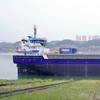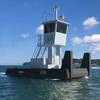GE Marine Engines announced that 36 GE LM aeroderivative gas turbines have accumulated more than 600,000 hours operating aboard 16 fast ferries.
Fast ferry operators have selected our gas turbines for a variety of propulsion system configurations. This milestone further demonstrates the outstanding reliability and availability of the LM gas turbines for fast ferry applications,” said Karl Matson, general manager of GE Marine Engines.
The Stena Explorer, a Highspeed Sea Service (HSS) catamaran, is the fast ferry that has operated the longest using GE gas turbines. The ship, which began operation in June 1996, is still in service today. The four GE gas turbines aboard sister HSS ship, Stena Voyager, have logged more than 160,000 hours in service, accumulating the highest number of operating hours for GE gas turbines used on a fast ferry.
GE remains a leading supplier of gas turbine-based propulsion systems for fast ferries. What follows is a brief overview of the company’s fast ferry experience.
The first gas turbine-powered fast ferry in Greece entered service in the summer of 2001. The Corsaire 14000-class monohull is powered by two GE LM2500+ gas turbines in a COmbined Diesel and Gas (CODAG) turbine arrangement with two diesel engines. The ship was built for operator Maritime Company of Levos (NEL), Piraeus, Greece, by Alstom Leroux Naval Shipyard in France.
There are twelve LM aeroderivative gas turbines in service on the three HSS fast ferries, Stena Explorer, Stena Voyager and Stena Discovery. Owner Stena Line AB, Gothenburg, Sweden, operates the HSS ferries on the Irish Sea and between the United Kingdom and The Netherlands.
Each semi-swath fast ferry has two LM1600 and two LM2500 gas turbines in a COmbined Gas and Gas (COGAG) turbine configuration. Finnyards in Rauma, Finland built the vessels. The HSS fast ferries measure 126 meters long by 40 meters wide. Each vessel can achieve speeds of more than 40 knots and have the capacity for 1,500 passengers, 375 cars, or 50 trucks and 100 cars.
Featured videos

Tracking Foreign Vessels Working in the U.S. Jones Act Market

Inmarsat Enhances Service to Drive Digitalization

Inside the Electrified Truckable Tug
Subscribe for
Maritime Reporter E-News
Maritime Reporter E-News is the maritime industry's largest circulation and most authoritative ENews Service, delivered to your Email five times per week









